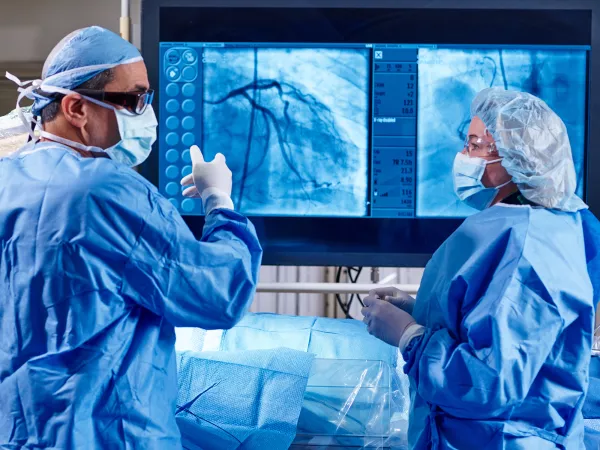How Dr Garcia's office supports long-term heart wellness with expert care
How Dr Garcia's office supports long-term heart wellness with expert care
Blog Article
Understanding the Importance of Cardiology in Modern Medical Care Services
Cardiology plays a vital duty in contemporary health care, specifically as heart condition remains to be the leading reason of death worldwide. Breakthroughs in diagnostics and treatment have actually changed patient treatment, making it possible for earlier treatments and boosted results. The shift towards preventive cardiology encourages individuals to handle their wellness proactively. As technology proceeds to evolve, the integration of ingenious remedies may better redefine cardiology's influence on public health, prompting a more detailed exam of emerging fads and their effects.
The Occurrence of Cardiovascular Disease and Its Influence on Public Wellness
Although heart illness continues to be the leading reason of death internationally, its influence extends much beyond individual people to affect public health systems and economies. The high frequency of heart disease places a significant strain on medical care sources, demanding raised funding for recovery, therapy, and avoidance programs. Public wellness campaigns have to deal with danger variables such as obesity, smoking cigarettes, and sedentary way of livings, which contribute significantly to the rising incidence of heart conditions.Moreover, the economic worry connected with cardiovascular disease is enormous, encompassing not only direct medical expenses but also indirect expenses associated to shed performance and premature death. Areas deal with difficulties in taking care of these prices, frequently resulting in variations in health care gain access to and results. As the population ages and lifestyle-related risks continue to rise, the necessity for effective cardiology interventions becomes extremely important. Subsequently, attending to heart illness is not only a matter of specific health and wellness however additionally an essential public wellness concern.
Breakthroughs in Heart Diagnostics and Imaging Techniques
Recent developments in cardiac diagnostics and imaging techniques have actually transformed the area of cardiology, boosting the capability to discover and monitor heart problem. Techniques such as cardiac MRI, CT angiography, and echocardiography have come to be progressively advanced, giving thorough pictures of cardiac structures and functions. These techniques permit the very early identification of problems like coronary artery condition, cardiac arrest, and valvular disorders.Moreover, innovations in non-invasive diagnostics, such as wearable innovation and remote monitoring devices, have encouraged people and doctor. These devices help with real-time tracking of heart rhythms and various other important indications, leading to prompt interventions. Additionally, expert system is being incorporated right into imaging analysis, boosting accuracy and effectiveness in diagnosis.
Advancements in Treatment Options for Heart Issues
Recent innovations in cardiology have caused significant technologies in treatment alternatives for heart problems. These include innovative medical techniques that improve step-by-step end results and emerging drugs that provide new avenues for therapy. As the field advances, these technologies play an important function in boosting client care and end results.
Advanced Surgical Techniques
Innovations in medical methods have actually transformed the landscape of cardiology, supplying brand-new wish for clients with heart conditions. Minimally invasive procedures, such as catheter-based treatments, have actually considerably lowered healing times and healthcare facility stays. Strategies like robotic-assisted surgical procedure improve precision, allowing cosmetic surgeons to browse complex anatomical structures with higher accuracy. Additionally, advancements in imaging innovation promote real-time visualization during procedures, improving end results. Transcatheter aortic shutoff substitute (TAVR) exhibits an innovation in treating aortic stenosis, enabling valve replacement without open-heart surgical procedure. Additionally, hybrid strategies that combine medical and catheter-based techniques give tailored remedies for different cardiac concerns. These sophisticated surgical methods not just enhance individual safety yet additionally broaden therapy alternatives, highlighting the vital role of technology in modern-day cardiology methods.
Emerging Drugs and Treatments
As the landscape of cardiology continues to evolve, emerging therapies and drugs play a crucial function in enhancing therapy options for heart disease. Technologies such as novel anticoagulants and advanced lipid-lowering representatives have actually transformed the monitoring of cardiovascular illness, considerably lowering patient morbidity and mortality. In addition, the growth of genetics therapies and regenerative medication uses appealing methods for treating conditions previously considered permanent. Clinical trials are constantly exposing the efficiency of these treatments, pushing the borders of standard therapies. The assimilation of digital health technologies facilitates personalized medication, enabling for customized therapy plans based on hereditary and way of living aspects. Collectively, these developments highlight the dynamic nature of cardiology, boosting client outcomes and redefining criteria of care in contemporary medical care.
The Function of Preventive Cardiology in Individual Treatment
Precautionary cardiology plays an important function in client care by concentrating on the recognition of threat variables that add to cardiovascular disease. Through lifestyle modification strategies and early discovery techniques, medical care suppliers can properly minimize the incidence of cardio occasions - Cardiology care. This proactive technique not only boosts person end results however also promotes long-term wellness
Danger Element Recognition
While heart diseases continue to be a leading reason for morbidity and mortality worldwide, efficient danger element recognition offers as a cornerstone of preventive cardiology. Determining danger variables such as hypertension, hyperlipidemia, diabetes mellitus, and household background is crucial for very early intervention. Healthcare experts utilize numerous screening methods to review these aspects, enabling customized preventive actions. Furthermore, recognizing a patient's way of living choices, such as smoking cigarettes and physical inactivity, better informs danger assessments. This complete examination enables medical professionals to develop individualized care plans focused on mitigating risks. By prioritizing risk element identification, health care systems can boost patient results and lower the overall burden of cardio conditions, ultimately contributing to boosted public wellness strategies and resource allocation.
Way Of Life Alteration Strategies
A wide range of research studies highlights the essential role of lifestyle adjustment techniques in lowering heart disease threat. These strategies encompass dietary changes, raised exercise, cigarette smoking cessation, and weight administration. By embracing a heart-healthy diet plan rich in fruits, vegetables, whole grains, and lean proteins, people can reduce cholesterol levels and blood pressure. Routine physical activity enhances the heart and enhances total cardiovascular health. Additionally, quitting smoking substantially minimizes the threat of heart condition and boosts recuperation prices for those with status quo. Weight management additionally adds to cardiovascular health by mitigating various other threat aspects such as diabetes mellitus and high blood pressure. Executing these lifestyle changes web link not only advertises private well-being but additionally functions as a cornerstone of precautionary cardiology in person treatment.
Very Early Detection Strategies
Lifestyle adjustments greatly add to reducing cardio condition dangers, but they are most reliable when coupled with early discovery methods. Preventative cardiology highlights the importance of recognizing prospective heart issues prior to they escalate right into major problems. Methods such as blood stress surveillance, cholesterol testing, and progressed imaging innovations like echocardiograms play essential duties in evaluating cardio health and wellness. Biomarkers and hereditary testing additionally enhance the accuracy of early detection, enabling tailored preventative techniques. Regular heart threat examinations encourage health care carriers to intervene proactively, potentially stopping cardiovascular disease and strokes (Dr Garcia). By integrating these very early discovery methods into regular treatment, patients can benefit from prompt way of living interventions and targeted treatments, inevitably improving results and boosting lifestyle
Integrating Modern Technology Into Cardiology Practices
As advancements in innovation proceed to reshape various fields, the combination of cutting-edge devices and systems right into cardiology techniques has actually become vital for boosting person treatment and end results. Telemedicine systems allow cardiologists to monitor clients remotely, enhancing accessibility to care while decreasing the worry on see here now healthcare centers. Wearable gadgets, such as smartwatches, make it possible for continuous heart rate surveillance, informing both physicians and clients to potential concerns in real-time. Additionally, man-made knowledge (AI) is being utilized to analyze huge quantities of heart data, assisting in early diagnosis and customized therapy plans. Advanced imaging techniques, including 3D echocardiography, enhance visualization of heart structures, bring about much more exact treatments. Digital wellness records (EHRs) enhance individual information management, ensuring that cardiologists have prompt accessibility to essential data. With each other, these technical improvements are transforming cardiology, advertising positive management and enhanced health outcomes for patients with cardio conditions.
The Value of Client Education And Learning and Involvement
Patient official statement education and learning and engagement play an essential role in the administration of cardio health. By furnishing patients with understanding concerning their conditions, treatment alternatives, and lifestyle adjustments, healthcare service providers equip people to take an active function in their treatment. This aggressive approach can result in boosted adherence to prescribed medications, dietary changes, and exercise programs, inevitably reducing the risk of complications.Engagement likewise promotes a solid patient-provider relationship, urging open communication and count on. When individuals feel notified and included, they are most likely to voice problems and ask questions, which can lead to better medical results. Furthermore, instructional sources, such as workshops or digital systems, can enhance understanding and advertise self-management techniques. On the whole, focusing on person education and learning and involvement is necessary for boosting cardio health and wellness, enhancing lifestyle, and minimizing medical care prices related to cardio illness.
Future Patterns in Cardiology and Their Potential Impact

Frequently Asked Inquiries
What Way Of Life Adjustments Can Decrease Cardiovascular Disease Threat?
The existing concern addresses way of living modifications that can significantly decrease heart problem risk. Dr Garcia. Taking on a balanced diet, engaging in normal physical task, maintaining a healthy and balanced weight, handling stress, and staying clear of tobacco can especially enhance cardiovascular health and wellness
How Can I Identify Early Indicators of Heart Issues?
Identifying early indicators of heart issues entails monitoring signs such as chest pain, shortness of breath, exhaustion, and irregular heartbeat. Timely understanding of these indications can motivate needed clinical assessment and treatment for far better end results.
What Are the Differences In Between Cardiologists and Heart Surgeons?
The differences between cardiologists and cardiac doctors lie in their roles; cardiologists mainly handle and diagnose heart conditions via non-invasive techniques, while heart doctors carry out operations to correct architectural heart issues. Each plays an important, distinctive role.

Just how Frequently Should I Obtain My Heart Health And Wellness Checked?
The regularity of heart medical examination varies based on individual threat aspects. Generally, grownups need to undertake evaluations every one to 2 years, while those with existing conditions might need more regular analyses as recommended by healthcare specialists.
What Role Does Genes Play in Cardiovascular Disease Danger?
Genetics significantly influences heart condition threat, with domestic patterns suggesting inherited conditions. Details genetics can predispose people to high blood pressure, cholesterol problems, and other cardiovascular troubles, highlighting the significance of genetic screening in evaluating heart wellness. Heart disease continues to be the leading reason of fatality globally, its impact expands much past specific patients to impact public wellness systems and economic climates. Public wellness campaigns have to resolve threat elements such as obesity, cigarette smoking, and inactive way of livings, which add considerably to the increasing occurrence of heart conditions.Moreover, the economic problem associated with heart condition is tremendous, including not just direct clinical prices however also indirect costs associated to lost performance and early death. Preventative cardiology plays an important role in patient treatment by concentrating on the identification of risk aspects that add to heart illness. Artificial intelligence (AI) and equipment learning are enhancing diagnostics and person tracking, allowing early discovery of heart illness. The distinctions between cardiologists and cardiac cosmetic surgeons exist in their duties; cardiologists largely diagnose and handle heart problems via non-invasive approaches, while cardiac cosmetic surgeons perform surgical procedures to remedy architectural heart problems.
Report this page